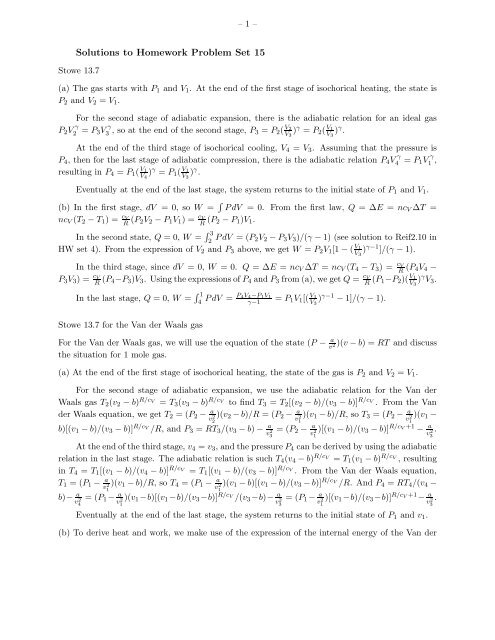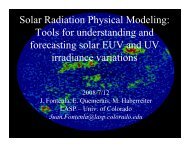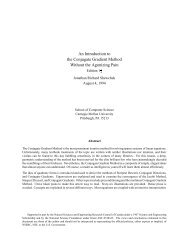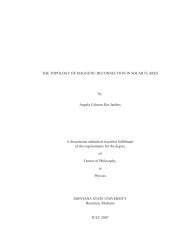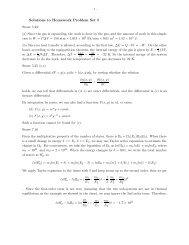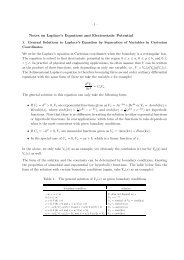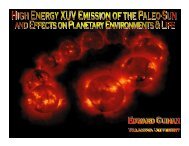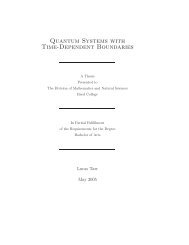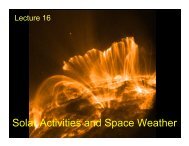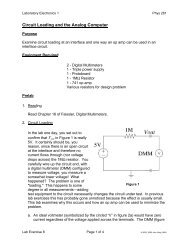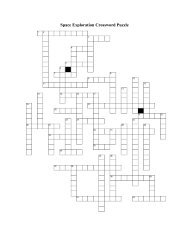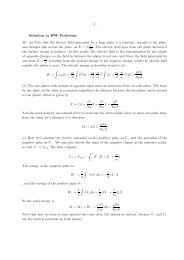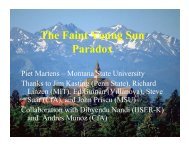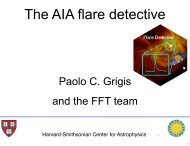Solutions to Homework Problem Set 15 - Solar Physics at MSU
Solutions to Homework Problem Set 15 - Solar Physics at MSU
Solutions to Homework Problem Set 15 - Solar Physics at MSU
Create successful ePaper yourself
Turn your PDF publications into a flip-book with our unique Google optimized e-Paper software.
– 1 –<br />
<strong>Solutions</strong> <strong>to</strong> <strong>Homework</strong> <strong>Problem</strong> <strong>Set</strong> <strong>15</strong><br />
S<strong>to</strong>we 13.7<br />
(a) The gas starts with P1 and V1. At the end of the first stage of isochorical he<strong>at</strong>ing, the st<strong>at</strong>e is<br />
P2 and V2 = V1.<br />
P2V γ<br />
2<br />
For the second stage of adiab<strong>at</strong>ic expansion, there is the adiab<strong>at</strong>ic rel<strong>at</strong>ion for an ideal gas<br />
= P3V γ<br />
3 , so <strong>at</strong> the end of the second stage, P3 = P2( V2<br />
V3 )γ = P2( V1<br />
V3 )γ .<br />
At the end of the third stage of isochorical cooling, V4 = V3. Assuming th<strong>at</strong> the pressure is<br />
P4, then for the last stage of adiab<strong>at</strong>ic compression, there is the adiab<strong>at</strong>ic rel<strong>at</strong>ion P4V γ<br />
4<br />
resulting in P4 = P1( V1<br />
V4 )γ = P1( V1<br />
V3 )γ .<br />
= P1V γ<br />
1 ,<br />
Eventually <strong>at</strong> the end of the last stage, the system returns <strong>to</strong> the initial st<strong>at</strong>e of P1 and V1.<br />
(b) In the first stage, dV = 0, so W = PdV = 0. From the first law, Q = ∆E = ncV ∆T =<br />
ncV (T2 − T1) = cV<br />
R (P2V2 − P1V1) = cV<br />
R (P2 − P1)V1.<br />
In the second st<strong>at</strong>e, Q = 0, W = 3<br />
2 PdV = (P2V2 − P3V3)/(γ − 1) (see solution <strong>to</strong> Reif2.10 in<br />
HW set 4). From the expression of V2 and P3 above, we get W = P2V1[1 − ( V1<br />
V3 )γ−1 ]/(γ − 1).<br />
In the third stage, since dV = 0, W = 0. Q = ∆E = ncV ∆T = ncV (T4 − T3) = cV<br />
R (P4V4 −<br />
P3V3) = cV<br />
R (P4−P3)V3. Using the expressions of P4 and P3 from (a), we get Q = cV<br />
R<br />
In the last stage, Q = 0, W = 1 P4V4−P1V1<br />
4 PdV = γ−1<br />
S<strong>to</strong>we 13.7 for the Van der Waals gas<br />
= P1V1[( V1<br />
V3 )γ−1 − 1]/(γ − 1).<br />
(P1−P2)( V1<br />
V3 )γ V3.<br />
For the Van der Waals gas, we will use the equ<strong>at</strong>ion of the st<strong>at</strong>e (P − a<br />
v 2)(v − b) = RT and discuss<br />
the situ<strong>at</strong>ion for 1 mole gas.<br />
(a) At the end of the first stage of isochorical he<strong>at</strong>ing, the st<strong>at</strong>e of the gas is P2 and V2 = V1.<br />
For the second stage of adiab<strong>at</strong>ic expansion, we use the adiab<strong>at</strong>ic rel<strong>at</strong>ion for the Van der<br />
Waals gas T2(v2 − b) R/cV = T3(v3 − b) R/cV <strong>to</strong> find T3 = T2[(v2 − b)/(v3 − b)] R/cV . From the Van<br />
der Waals equ<strong>at</strong>ion, we get T2 = (P2 − a<br />
v2 )(v2 −b)/R = (P2 −<br />
2<br />
a<br />
v2 )(v1 −b)/R, so T3 = (P2 −<br />
1<br />
a<br />
v2 )(v1 −<br />
1<br />
b)[(v1 − b)/(v3 − b)] R/cV /R, and P3 = RT3/(v3 − b) − a<br />
v2 = (P2 −<br />
3<br />
a<br />
v2 )[(v1 − b)/(v3 − b)]<br />
1<br />
R/cV +1 a −<br />
v2 .<br />
3<br />
At the end of the third stage, v4 = v3, and the pressure P4 can be derived by using the adiab<strong>at</strong>ic<br />
rel<strong>at</strong>ion in the last stage. The adiab<strong>at</strong>ic rel<strong>at</strong>ion is such T4(v4 − b) R/cV = T1(v1 − b) R/cV , resulting<br />
in T4 = T1[(v1 − b)/(v4 − b)] R/cV = T1[(v1 − b)/(v3 − b)] R/cV . From the Van der Waals equ<strong>at</strong>ion,<br />
T1 = (P1 − a<br />
v2 )(v1 − b)/R, so T4 = (P1 −<br />
1<br />
a<br />
v2 )(v1 − b)[(v1 − b)/(v3 − b)]<br />
1<br />
R/cV /R. And P4 = RT4/(v4 −<br />
b)− a<br />
v 2 4<br />
= (P1 − a<br />
v2 )(v1 −b)[(v1 −b)/(v3−b)]<br />
1<br />
R/cV /(v3 −b)− a<br />
v2 3<br />
= (P1 − a<br />
v2 )[(v1 −b)/(v3−b)]<br />
1<br />
R/cV +1 a −<br />
v2 .<br />
3<br />
Eventually <strong>at</strong> the end of the last stage, the system returns <strong>to</strong> the initial st<strong>at</strong>e of P1 and v1.<br />
(b) To derive he<strong>at</strong> and work, we make use of the expression of the internal energy of the Van der
Waals gas E = cV T − a<br />
v + const..<br />
– 2 –<br />
In the first stage, since dv = 0, W = 0, so Q = ∆E = cv(T2−T1)−a(1/v2 −1/v1) = cv(T2−T1).<br />
From the expressions of T2 and T1 in (a), we get Q = cV<br />
R [(P2 − a<br />
v2 )(v2 − b) − (P1 −<br />
2<br />
a<br />
v2 )(v1 − b)] =<br />
1<br />
cV<br />
R (P2 − P1)(v1 − b).<br />
In the second stage, Q = 0, W = −∆E = cV (T2 − T3) − a(1/v2 − 1/v3). Using the expressions<br />
of T2 and T3 in (a), we get W = cV<br />
R [(P2 − a<br />
v2 )(v2 − b) − (P2 −<br />
2<br />
a<br />
v2 )(v1 − b)[(v2 − b)/(v3 − b)]<br />
1<br />
R/cV ] −<br />
a(1/v2 − 1/v3) = cV<br />
R [(P2 − a<br />
v 2 1<br />
)(v1 − b) − (P2 − a<br />
v2 )(v1 − b)[(v1 − b)/(v3 − b)]<br />
1<br />
R/cV ] − a(1/v1 − 1/v3) =<br />
cV<br />
R (P2 − a<br />
v2 )(v1 − b)(1 − [(v1 − b)/(v3 − b)]<br />
1<br />
R/cV ) − a(1/v1 − 1/v3).<br />
In the third stage, W = 0, and Q = ∆E = cv(T4 − T3) = cV<br />
R [(P1 − a<br />
v2 )(v1 − b)[(v1 − b)/(v3 −<br />
1<br />
b)] R/cV − (P2 − a<br />
v2 )(v1 − b)[(v1 − b)/(v3 − b)]<br />
1<br />
R/cV ] = cV<br />
R (P1 − P2)(v1 − b)[(v1 − b)/(v3 − b)] R/cV ].<br />
In the last stage, Q = 0, and W = −∆E = cV (T4 − T1) − a(1/v4 − 1/v1) = cV<br />
R [(P1 − a<br />
v2 )(v1 −<br />
1<br />
b)[(v1 − b)/(v3 − b)] R/cV − (P1 − a<br />
v2 )(v1 − b)] − a(1/v3 − 1/v1) =<br />
1<br />
cV<br />
R (P1 − a<br />
v2 )(v1 − b)([(v1 − b)/(v3 −<br />
1<br />
b)] R/cV − 1) − a(1/v3 − 1/v1).<br />
Compare he<strong>at</strong> and work for the Van der Waals gas with those for the ideal gas, it is seen th<strong>at</strong> P for<br />
the real gas is replaced by P − a<br />
v2, and V is replaced by v − b. In addition, in the non-isochorical<br />
stages, the change in the internal energy of the Van der Waals gas should also include the change<br />
in the interaction potential energy a/v.<br />
Importantly, for the Van der Waals gas, cP = cV + R, so γ − 1 = R/cV . Therefore, we<br />
cannot directly use γ in the expressions of he<strong>at</strong> and work for the Van der Waals gas. We may<br />
find the r<strong>at</strong>io of specific he<strong>at</strong>s for the Van der Waals gas in the following approach: dQ = TdS =<br />
T∂S/∂T |V dT +T∂S/∂V |TdV . Using the Maxwell rel<strong>at</strong>ion ∂S/∂V |T = ∂P/∂T |V and the definition<br />
cV = T∂S/∂T |V , the above becomes dQ = T∂S/∂T |V dT +T∂P/∂T |V dV = cV dT +T∂P/∂T |V dV .<br />
By definition, cP = ∂Q/∂T |P = cV +T∂P/∂T |V ∂V/∂T |P . The partial deriv<strong>at</strong>ives on the righthand<br />
side of the equ<strong>at</strong>ion may be derived by differenti<strong>at</strong>ing the Van der Waals equ<strong>at</strong>ion: (v −b)dP +[P +<br />
a<br />
v2 − 2a(v−b)<br />
v3 ]dV = RdT, which gives ∂P/∂T |v = R/(v − b) and ∂v/∂T |P = R/[P + a<br />
v2 − 2a(v−b)<br />
v3 ].<br />
Therefore, cP = cV + R2T/[(v − b)[P + a/v2 − 2a(v − b)/v3 ]] = cV + R2T/[RT − 2a(v − b) 2 /v3 ],<br />
and γ = cP/cV = 1 + R/cV RT/[RT − 2a(v − b) 2 /v3 ].


